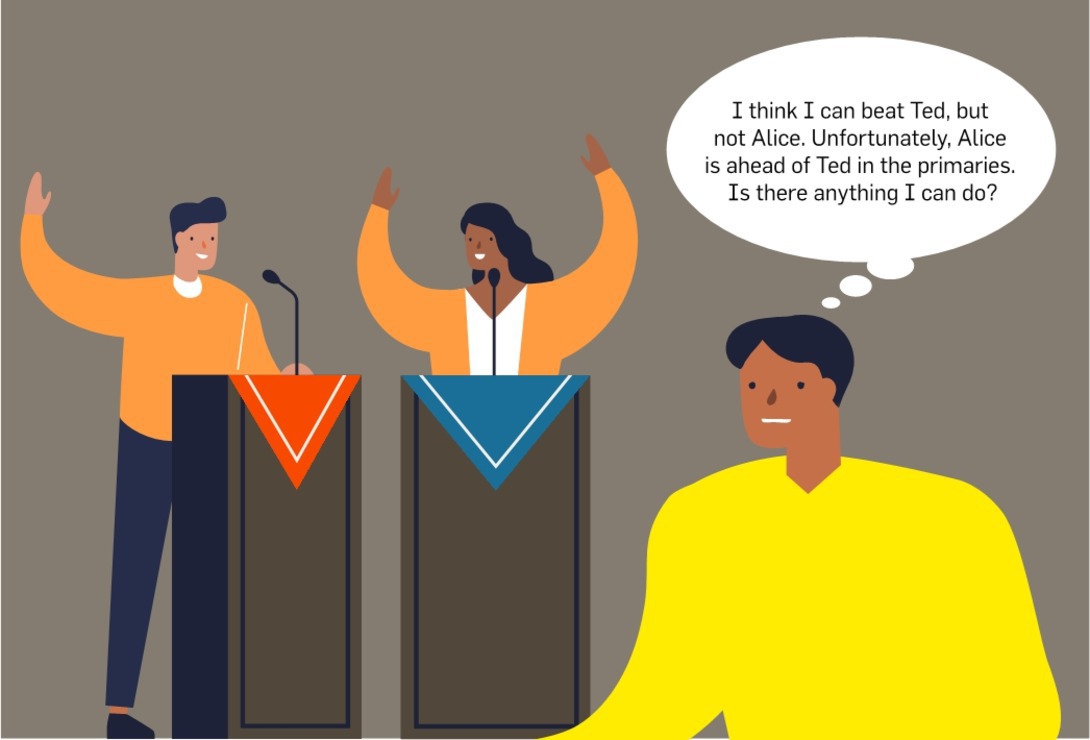Bob is from party A. Alice and Ted are from party B.
35% of the voters prefer Bob to Alice to Ted (Bob > Alice > Ted)
36% prefer Alice to Bob to Ted (Alice > Bob > Ted)
29% prefer Ted to Alice to Bob (Ted > Alice > Bob)
Each party holds a primary election. The winner of the primary advances to the final election in which it is one against one.
In a runoff election, Bob would lose to Alice, but win against Ted who is considered too extreme by most voters.
Anyone can vote in the primary.

Warm-Up: Can Bob’s supporters influence the election by participating in the primary for party B?
Solution to Warm-Up:
Yes. Bob’s supporters vote for Ted in the primary for party B. If Ted wins the primary, then, in the final election, only the 29% who support Ted above Bob will vote for Ted. So Bob will win by a landslide.
But this strategy gives that result only if there are no abstentions. Suppose someone will vote in the final election only if his/her favorite candidate is on the ballot. Otherwise, that voter will abstain.
Warm-Up 2: In an abstention setting, what should Bob’s supporters do given the stated preference profiles?
Solution to Warm-Up 2: Bob still wins if Ted wins the primary for party B, though only by 35% vs. 29%. So Bob’s supporters should still vote for Ted.
Question:
Can you construct a set of preference profiles such that Alice would win over Bob in a one-against-one contest when there are no abstentions but would lose if voters would abstain if their top candidate is not on the ballot.
Solution: Here is one possibility:
41% Bob > Alice > Ted
39% Alice > Bob > Ted
20% Ted > Alice > Bob
Alice will beat Bob by 59% vs. 41% if there are no abstentions. Bob will beat Alice by 41% to 39% if there are abstentions by Ted supporters.
End solution
This leads to a strategy for the supporters of Bob even if they cannot vote in the primaries for party B: urge voters for Ted to abstain in the general election if Ted does not win the primary for party B. That is, the supporters of Bob should encourage a “Ted or bust” strategy among the supporters of Ted.
It is customary in the voting literature to honor Nicolas de Condorcet. In that spirit, and in a slight variant of standard voting theory terminology, we’ll call a candidate C a pure Condorcet candidate if he or she wins against every other candidate X when there are no abstentions (that is C is favored over X more than X is favored over C). In the this solution, Alice is a pure Condorcet candidate because she beats Bob 59% to 41% and beats Ted by 80% to 20%. We’ll call a candidate C an abstention Condorcet candidate if he or she wins against every other candidate X when voters will abstain if their top candidate is neither C nor X. Bob is the abstention Condorcet candidate because he will beat Alice by 41% to 39% when the Ted-is-our-favorite voters abstain and he will beat Ted by 41% to 20% when the Alice-is-our-favorite voters abstain.
In a fit of political good will, leaders of both major parties agree that there should just be one election using a top-2 approval voting protocol. In that protocol, voters will assign one vote to both of their top two candidates in their preference profile and no votes to anyone else. The candidate with the most votes wins.
Question: In a top-2 approval voting protocol, is there any situation in which a candidate who is both a pure and abstention Condorcet candidate loses.
Solution: Here is one collection of preference profiles where that holds:
88% Alice > Bob > Ted
12% Ted > Bob > Alice
Alice would beat both Bob and Ted in a one-against-one election whether or not there are abstentions, but would still lose to Bob in an approval setting because Alice will get 88 approval votes while Bob will get 100. End of solution.
Consider a weighted approval protocol in which a voter sorts the n candidates in descending order of preference and gives n votes to the first candidate in the sorted order, n-1 to the second, …, 1 vote to the last.
Question: Could a candidate be both the pure and abstention Condorcet candidate and still lose in the weighted approval protocol?
Solution: Remarkably, I it is still possible. This time, let’s solve the question symbolically. Consider the following set of preference profiles from the last solution:
X% Alice > Bob > Ted
(100-X)% Bob > Ted > Alice
In the weighted approval protocol assuming a total of 100 voters and these three candidates:
Alice gets 3X + 100-X = 2X + 100
Bob gets 2 X + 300 – 3X = 300 – X
Ted gets X + 200 – 2x = 200 – X
X > 100-X for Alice to beat Bob (or Ted) either with or without abstentions in a one-against-one contest.
For Bob to win in the weighted approval setting, 300 – X > 2X + 100. Or X < 66 2/3.
Thus, for example, the following preference profiles would work for Bob.
60% Alice > Bob > Ted
40% Bob > Ted > Alice
Without abstentions, in a 1-against-1 race, Alice beats Bob by 60% to 40%. With abstentions, Alice beats Ted 60% to 0%. . However, in the weighted approval protocol on 100 voters, Alice will receive 180 + 40 = 220 votes. Bob will receive 120 + 120 = 240 votes.
End of solution.
Upstart 1: Can you find some kind of weighted approval voting protocol for which, given any set of preference profiles that has a candidate C who is both a pure and abstention Condorcet candidate, C will win in a three-way race using your protocol.
Upstart 2: Same question as for Upstart 1, but for an n-way race.




Join the Discussion (0)
Become a Member or Sign In to Post a Comment